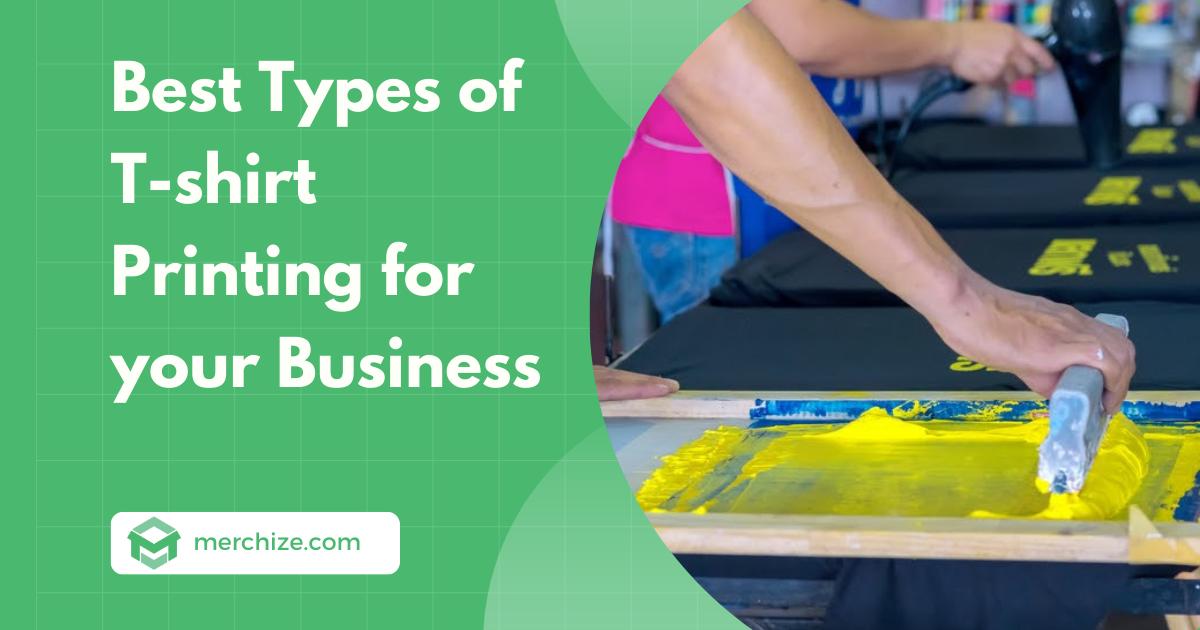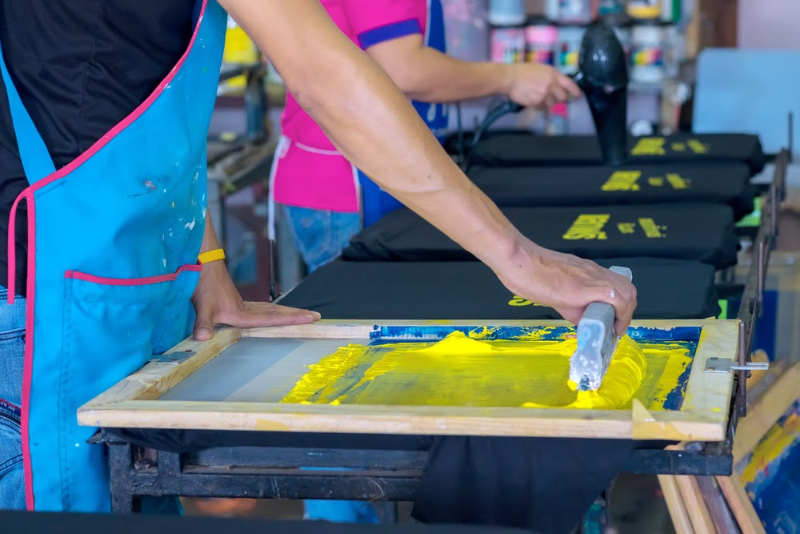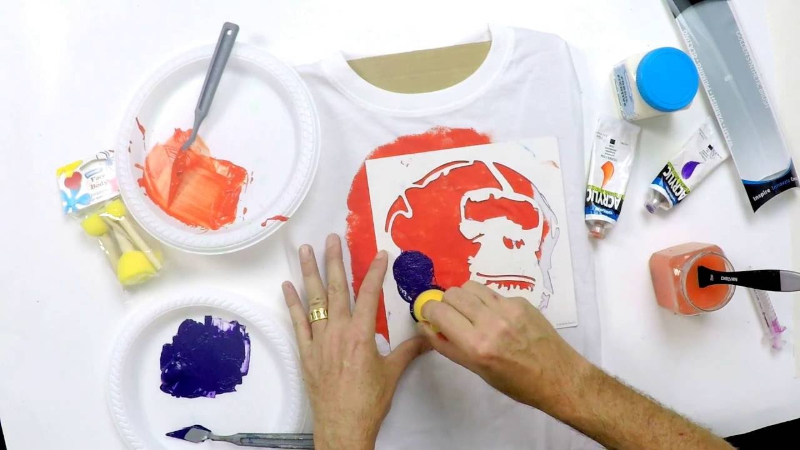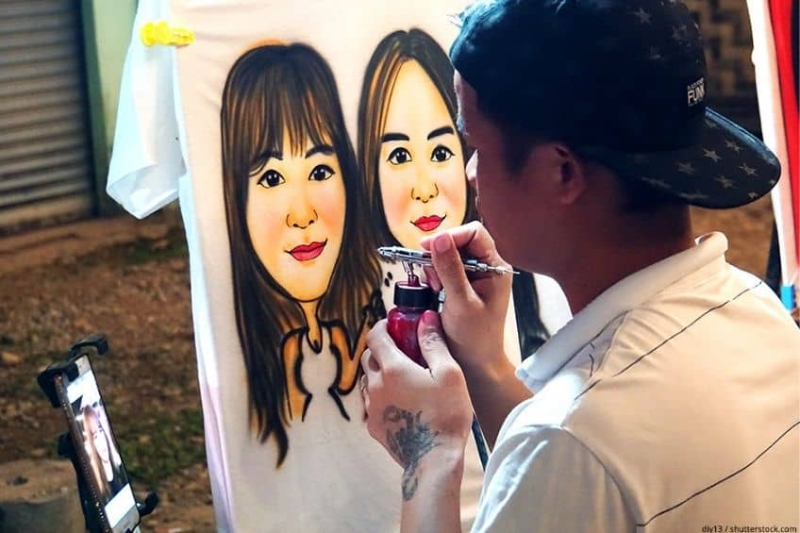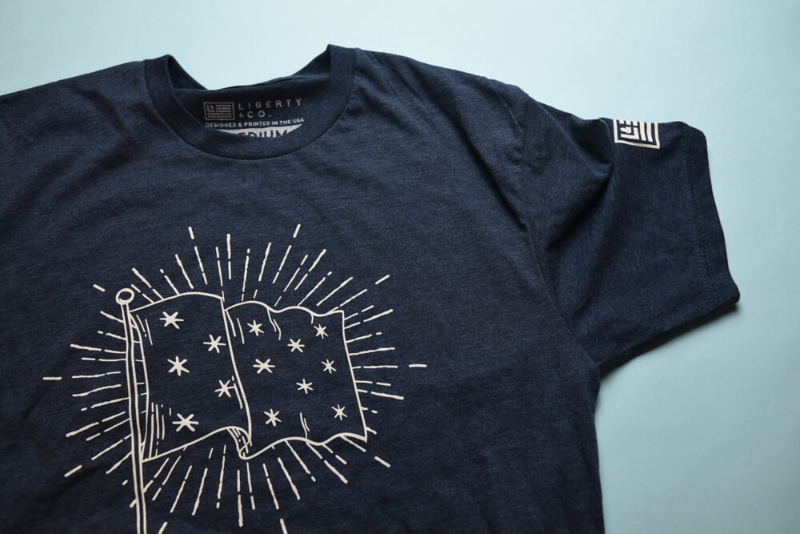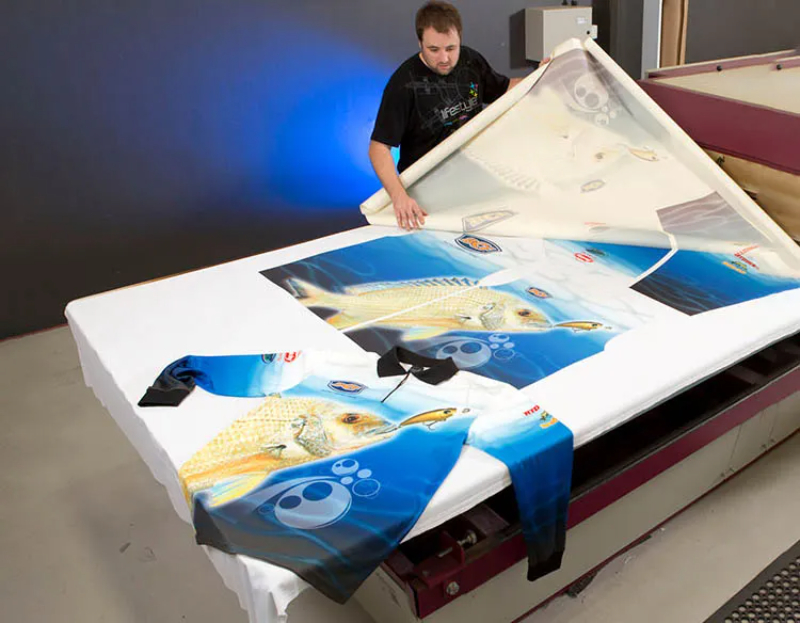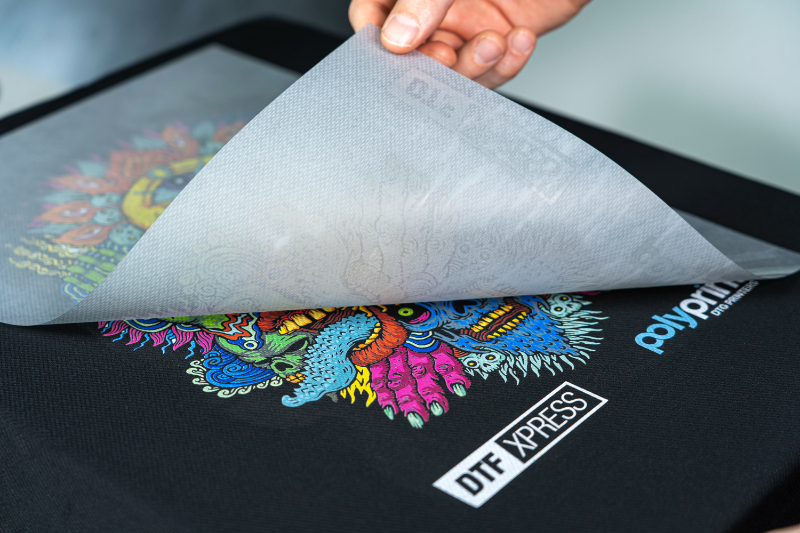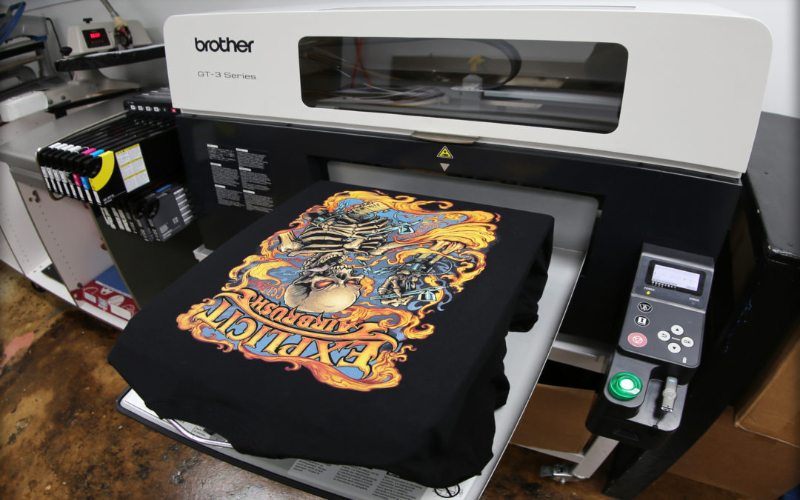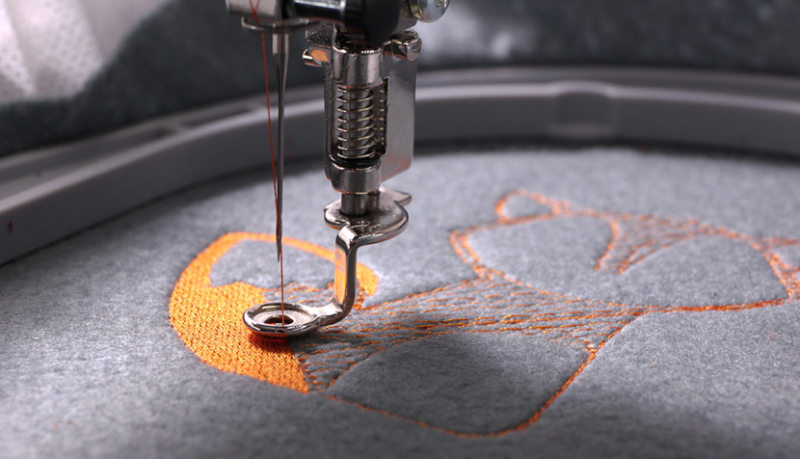Contents
- Traditional Printing Techniques
- Heat Transfer Printing Techniques
- Digital Printing Techniques
- How to find the best types of T-shirt printings?
- Best T-shirt printing methods at home
- How to print on T-shirts at home
- Use Multiple Types of Shirt Printing with Merchize
- What Printing Methods Does Merchize Offer?
- How to Create T-shirts with Merchize?
- FAQs
When it comes to creating custom apparel, choosing the right t-shirt printing method is essential. From classic screen printing to high-tech direct-to-garment, there are now more options than ever for creating custom apparel. This updated guide will introduce you to 10 popular types of t-shirt printing methods detailing the pros and cons of each technique. This helps you find the right printing option for your business to boost sales.
Traditional Printing Techniques
While digital printing has grown in popularity, traditional printing techniques remain the go-to choices for many custom apparel businesses that cater to durability, vibrant colors, cost-effectiveness for bulk orders, and versatility.
Screen printing
Screen printing, also known as silkscreen printing, is a printing technique where ink is pushed through a stencil (a mesh screen with a design) onto the printing surface (like a t-shirt). The areas of the stencil that are not part of the design are blocked off, so the ink only goes through the negative areas of the mesh screen that correspond to the design.
This printing method uses a squeegee to force ink through the woven mesh stencil onto the shirt. The squeegee pressure allows more ink to penetrate the fabric for a thicker print. The stencil is made by blocking off parts of the mesh with an emulsion or film positive. The areas that are left open create the print design.
Screen printing requires a separate stencil for each color in the design. This means complex multi-color prints require more setup time. The ink is applied one color at a time, with drying in between each layer. This builds up the colors to create a bright, opaque print. Screens can be reused many times overruns of the same print design, making it cost-effective for bulk orders.
This printing method is widely used for a long time due to its simplicity and high-quality printing. In the past, the screen printing process was done mostly by hand. Now, new machines are taking over in most stages of production, which cuts down on labor costs as well as time.
The ink used in screen printing is thicker and more opaque than other printing techniques, resulting in higher quality and more vibrant print. Screen-printed shirts tend to have a distinctive thicker feel compared to other methods, as the ink sits on top of the fibers.
Pros:
- High-quality and long-lasting prints: The ink is also absorbed into the fabric, which means that it won’t peel or fade easily. This makes screen printing a popular choice for t-shirts and other apparel that will be worn frequently.
- Vibrant colors and unique printing effect: The ink used in screen printing is thicker, which gives it stronger vibrancy. It’s also why screen printing can be used on both light and dark-colored fabrics to produce vivid and eye-catching designs
- Can be used on a variety of fabrics: Screen printing can be used on cotton, polyester, and blends, which makes it a popular choice for a wide variety of apparel and promotional products.
- Fast process: Quick process allows you to print a large number of products within a short period of time.
- Cost-effective for large orders: Screen printing is a cost-effective choice for larger orders of t-shirts. After the initial set-up, you can reuse it to print as many products as you wish. The setup costs can be spread out over a large number of prints, which means that the cost per t-shirt decreases as the number of t-shirts ordered increases.
Cons:
- Limited printing area: The printing area is restricted to the size of the stencil. Screen printing won’t be able to cover the entire fabric.
- More labor-intensive than other printing techniques: Screen printing requires a lot of manual labor compared to other newer modern printing techniques. Preparing the stencil, aligning the design, and applying the ink – all of these steps require human involvement.
- Limited color options: Each color requires a separate screen and printing pass. The more colors you want to print, the more screens and labor it takes to transfer your designs onto the fabric. It is also hard to portray intricate colors accurately and consistently. That’s why screen printing is only used for designs with a few simple colors.
- Not cost-effective for small quantities of T-shirts: This printing technique requires extensive setup for each individual design. You must pay for screens, emulsion, coating tools, inks, etc. For a small batch of t-shirts, it wouldn’t be economical to use screen printing.
Stenciling
Stenciling is a simple form of screen printing that requires only a few simple tools and setups to print a design. There is no need for a silkscreen or special tool. Anything that will give the negative space prints will do. You can either cut out the design by hand or use your Cricut at home. The next step is to apply your ink over the stencil using a brush, sponge, or stippling tool.
This traditional printing method involves placing a stencil directly against the t-shirt fabric. Ink is then applied through the cutout areas of the stencil, imprinting the design. Stencils can be made from cardstock, acetate, or even household materials like cardboard. Multiple stencil layers are needed for multicolor prints.
Stenciling would not produce the highest quality prints compared to commercial screen printing methods. The edges of the design tend to be less defined. However, it is a super simple and fun DIY printing solution for anyone to try at home. Professionals printing bulk orders would want to use more advanced techniques for better quality and efficiency.
If you want to make customized t-shirts as a fun weekend project or to print a few shirts for family and friends, stenciling is a good beginner option to try out. It allows you to experiment with designs with minimal startup costs. Just be sure to use fabric paints or inks designed specifically for shirt printing.
Pros:
- Versatility: Stencil printing allows for flexibility in design and creativity. Various materials can be used to create stencils, enabling the printing on different surfaces, including fabric, wood, walls, and more.
- Low cost: Stencil printing can be a cost-effective method since stencils can be made from inexpensive materials, such as cardboard or acetate sheets. It is particularly beneficial for one-time or occasional projects.
- DIY-friendly: Stencil printing is accessible and achievable for do-it-yourself enthusiasts. With simple tools and materials, individuals can create their own stencils and print personalized designs on various items.
Cons:
- Limited details: Stencil printing may have limitations when it comes to intricate details or complex designs. The cut-out sections in the stencil restrict the level of intricacy that can be achieved in the final print.
- Time-consuming for multi-colored prints: Stencil printing requires individual stencils for each color used in the design. This can be time-consuming when working with multi-colored prints, as each color requires a separate application and drying time.
- Not suitable for large quantities: Stencil printing is generally more suitable for smaller quantities of prints due to the manual process involved. It may become time-consuming and labor-intensive when attempting to produce large quantities.
Airbrush
Airbrushing is a unique printing technique that requires a certain level of craftsmanship and creativity to execute. Unlike other printing methods, you are not relying on any tools but your own hands. With this technique, you will spray paint directly onto the fabric using an airbrush tool.
The airbrush consists of a nozzle, needle, and compressor. The compressor propels the paint or ink through the nozzle which atomizes it into a fine mist. This allows for smooth, controlled, and detailed application of the paint onto the garment. The needle is used to regulate the amount of paint flow.
With airbrushing, the artist is able to create subtle blends, gradients, and photorealistic effects by layering light mists of paint. The technique provides a high level of precision and softness that gives a hand-painted appearance. Designs can cover large areas or include fine detail work.
An experienced airbrush artist can create stunning visual effects like shading, shadows, and textures that would be difficult to achieve with standard printing methods. It is commonly used for complex illustrations, customization, and mimicking the softness of photography. The learning curve is steep but rewards artistic skill.
Airbrushing allows full creative freedom when printing on t-shirts, unlike templates and separations required for screen printing. But it is less efficient for mass production due to the hands-on effort required. Each shirt is unique.
Pros:
- Precise and detailed: Using airbrushing, the artist has precise control over the application of paint or ink to create special and intricate details like smooth gradients or shading. It is the best printing technology out there to create seamless and smooth gradient effects, layer and build up the colors.
- Versatility: Airbrushing can be applied on various surfaces, including paper, canvas, metal, plastic, and even fabrics. Whether you want to create T-shirt prints, customize vehicles, do body art, etc., airbrushing can do it all.
- Room for creativity: With this printing technique, artists are able to experience and turn their vision into art.
Cons:
- It takes time to learn and practice to achieve consistent spray patterns, control the flow of paint or ink, and master the art of airbrushing. It’s hardly possible to make stunning airbrushing paint on the first try.
- Not durable print: Airbrush paint can be washed out easily and can not last very long. It is not a practical way to make T-shirts for daily use.
- Not suitable for large orders: Since the print is done by hand, it would take a long time to make a large order. Moreover, it is also hard to create consistent results throughout the process.
In conclusion, airbrush is best for DIY unique, intricate T-shirt designs but unsuitable for mass-produced orders.
Discharge Printing
Discharge printing is far less popular than DTG or dye sublimation but results in unique-looking prints. This method is mostly used to create vintage, distressed t-shirt designs which are popular fashion styles.
The discharge printing process removes dye from the fabric rather than depositing it. It works by applying a discharge paste through a screen onto the dyed cotton shirt. The paste reacts with the fabric dye molecules, essentially bleaching out the color in the printed areas. The result is a soft hand feel and a faded, worn-in look.
Since the original dye molecules are removed, the printed areas allow the natural cotton color to show through. The discharge agent only removes the top layer of dye, revealing the undercolor. This allows for a layered effect with the undercolor providing a vintage tint.
Discharge printing is ideal for achieving a softer hand and a color-weathered appearance compared to standard pigment printing. It can create tones and effects that are not possible with depositing inks. The environmental impact is also lower since no plastisol inks are used.
The biggest downside is that discharge printing only works on natural fabrics that accept dye. It cannot be used on polyester or synthetic blends. Overall, it is great for recreating vintage rock shirts, creating monochromatic effects on colored shirts, or just getting that perfectly worn and faded look.
Heat Transfer Printing Techniques
Unlike traditional printing methods where ink is directly applied to fabric, heat transfer printing first prints the design onto a transfer medium which is then heat pressed onto the garment. There are several types of heat transfer processes, each with their own advantages.
One common method is vinyl heat transfer. Here, the design is printed in reverse onto a thin vinyl material using digital printing or plotter cutters. The vinyl is then peeled off its backing and heat-pressed onto the shirt. The vinyl layer sticks to the fabric, resulting in a very soft and flexible print. Vinyl is great for crisp logos and text elements.
Sublimation transfer involves printing dyes onto coated paper sheets which are pressed onto polyester fabrics. The heat causes the dyes to vaporize and bond with the synthetic fibers for an all-over print. This photo-realistic method works well for full-color allover designs and is very durable.
Other specialty heat transfers include flocked, foil, glitter, and more. Each material and technique creates a different tactile effect on the garment. Overall, heat transfer printing is preferred for versatility, ease of application, and ability to print on varied fabrics and objects. It’s less setup-intensive than traditional methods for small-batch production.
Dye Sublimation (AOP)
Dye sublimation is a popular printing technique for t-shirts that results in vibrant, photorealistic designs. It shares similarities with heat transfer printing in that the design is first printed onto coated paper before being transferred to the fabric. However, sublimation uses a specialized dye-based ink.
When heat is applied, the sublimation ink turns into a gas that easily penetrates and bonds with synthetic fibers like polyester. As the garment cools, the ink solidifies and becomes part of the fabric rather than sitting on the surface. This bonding process allows for permanent coloration that doesn’t fade or crack over time.
The dyes diffusing into the polymeric fibers also create continuous tones that blend smoothly, mimicking photographs. This allows for exceptional color quality and accuracy. The entire design can also bleed to the edges for a true all-over print.
Sublimation is only suitable for synthetic fabrics due to the chemical bonding requirement. The higher the polyester content, the better the vibrancy and clarity. It excels at printing synthetic performance wear, soft signage, flags, and polyester-blend t-shirts.
The upfront costs of sublimation systems can be high but it is very efficient at production of short runs. Overall, it produces photorealistic, durable, and high-quality prints unmatched by other techniques.
Pros:
- Durable prints: Dye sublimation prints resist fading, peeling, and wearing out very effectively. The print can last a long time despite repeated washing, exposure to sunlight, and all wear and tear in general. This is the perfect type of T-shirt printing, especially for making everyday T-shirts.
- High-quality print: With dye sublimation, you can get prints with intricate details with beautiful vibrant colors. Also, it is effective for reproducing photos and complex designs with precision.
- Best for AOP: Unlike traditional printing methods, this type of printing can cover a large area of fabric, which makes it the suitable option for making all-over print products. Designs will be printed on a large sheet of fabric, then cut and sewed into complete products.
Cons:
- Not compatible with natural fibers: Dye sublimation is most effective on polyester fabrics or materials with a polymer coating because the special ink used for dye sublimation is made to bond with polyester molecules. That’s also why natural fibers such as cotton or silk are not compatible with this type of printing.
- Costly equipment: Dye sublimation printing requires considerable initial investment for printing equipment like sublimation printers, heat presses, inks, etc. It doesn’t stop there. In order to make an AOP T-shirt, you also have to cut and sew the fabrics into the final product, which adds more costs in the making. For this reason, this type of printing is most suitable for businesses and individuals who own large-scale production.
Other than T-shirt printing, this printing technique is also applicable to a wide range of apparel and decoration products. Look for more new and exciting sublimation products, look up our list of all Dye Sublimation products.
Direct-to-film (DTF)
Direct-to-film is one of the latest technologies to innovate the printing industry. This new method of printing uses eco-friendly water-based inks and requires no pre-treatment, allowing a more versatile and efficient process.
This new printing method can be described as a bridge between Direct-to-garment and Direct to Garment.
Similar to other transferring printing methods, Direct-to-film printing uses a special PET film (Polyethylene Terephthalate) for transferring prints into the fabric. Thermo-adhesive power then is applied to the film and heat-pressed to the final substrate, resulting in vibrant and detailed prints.
On the other hand, Direct-to-film printing is similar to Direct to garment printing as it is applicable to a wide range of materials, including both polyester and cotton fabrics.
Pros:
- Versatility: This printing method is preferred over other traditional printing as it is compatible with various fabric options, be it natural or synthetic, which leads to more production possibilities.
- Durability: Direct-to-film printing is widely recognized for its outstanding durability against washing and stretching. It can last longer, regardless of the material choices.
- High-quality printing: While meeting the requirements of being versatile and durable, DTF also doesn’t compromise printing quality. It provides bright and beautiful and vibrant prints that won’t wash out after repeated washing.
Cons:
- Limited printing area: The printer can only cover a certain area but not the entire fabric, which is similar to DTG printing. For this reason, it is best applied for printing T-shirts, pillowcases, tote bags, etc. This printing option isn’t suitable for AOP products.
- Complicated process: Compared to Dye sublimation or DTG printing, DTF can be a bit more complicated with the addition of film, adhesive powder, and so on.
Digital Printing Techniques
Digital printing refers to all printing techniques that produce printed materials from digital files. This set of technologies ditches all the manual processes or traditional printing plates. Instead, the printing process is digitalized and mechanized to be faster and more cost-effective.
Heat transfer printing techniques are also a type of digital printing. Yet, there are still a few other options that are used for printing on various materials.
Direct-to-garment printing
Direct-to-garment (DTG) printing uses specialized inkjet printers to print designs directly onto clothing and textiles. It involves spraying thousands of micro-droplets of aqueous ink onto the fabric to build up continuous tone images with photorealistic quality.
The DTG printer nozzles apply the acrylic-based inks in CMYK colors which penetrate the fabric without creating a heavy feel. The garment remains soft and breathable. Pretreatments are applied to cotton materials prior to printing to prepare the fibers.
DTG excels at translating complex graphics, photographs, illustrations, and vector art into high-resolution prints. The level of image detail surpasses screen printing. It also allows printing light colors onto dark-colored shirts.
Smaller independent apparel companies prefer DTG for on-demand production, customization, and short print runs. While the printers have a higher upfront cost, the ability to print individual shirts makes overall production costs lower. No screens, plates, or setup are required.
DTG is the best digital method for recreating photographic images on t-shirts with crisp details, smooth gradients, and full bleed printing. The eco-friendly water-based inks create a soft hand-feel close to dye sublimation. It empowers artists and designers to effortlessly apply their designs on apparel.
Pros:
- Good quality printing: DTG is a great solution for making highly detailed and colorful designs.
- Fast production: Among the fastest printing techniques. It does not require a complicated setup and process. A product can be easily printed within a few minutes.
Cons:
- Only compatible with cotton fabrics: This Direct-to-garment printing is only suitable for cotton material or high cotton content fabrics.
- Not durable: DTG print is not made to last no matter what. If washed repeatedly or worn frequently, the printing quality goes down quite fast. For this reason, these DTG t-shirts are best suitable for promotional products, team uniforms, corporation or event gifts, etc.
- Not suitable for AOP: DTG printers only provide a limited printing area which is more or less around 16×20 inches. It cannot cover the entire fabric, which is why DTG is not suitable for All-over print. Moreover, DTG works best on flat surfaces. But when it comes to irregular surfaces like sleeves or collars, it shows weakness. In this case, dye sublimation is the better option.
Embroidery
Embroidery is a decoration technique that uses stitched thread designs rather than printing inks. While not a true printing method, it is commonly used to add logos, motifs, names, and customization to t-shirts and other apparel.
Embroidery can be done by hand using stitching hoops, frames, and needles. However, commercial embroidery is typically done using computerized embroidery machines. These machines translate digital artwork files into stitch-by-stitch instructions.
The automated machine then sews the patterns onto the fabric using specialty threads, metallic threads, and various stitch effects are possible. Multi-head machines allow mass production of embroidered apparel.
Embroidery creates a dimensional, textured look compared to flat printing. The threads add striking visual interest and depth. Since the stitching penetrates the fabric, the designs are very durable and permanent. Embroidery is ideal for company logos, monograms, and high-contrast elements.
However, embroidery lacks the photorealism, blending, and edge bleed effects of printing. The number of colors in a design is limited by the threads. Fine details can be lost. Placement options are also restricted by hooping. Still, embroidery is an impactful decoration technique alongside printing.
Pros:
- Durability: Embroidery creates designs that are highly durable and long-lasting on T-shirts. The stitching is secure, ensuring that your design will withstand the test of time, even after multiple washes. It sticks with the materials through thick and thin.
- Unique hand feel and texture: Delicate stitches add texture to the blank fabrics and create an interesting hand feel to the product.
- Polished and elegant look: Compared to ink-based printing methods, embroidery offers a much more intricate, polished look.
Cons:
- Expensive cost: Embroidery, even when done by machine, can be quite expensive compared to other printing methods. It takes longer to prepare and finish. But, it should be noted that embroidery lasts longer and the result is much more sophisticated. Customers are also willing to pay more for embroidered T-shirts than regular printed ones.
- Limited colors: Stitch, unlike ink, can’t be blended to create new colors. Embroidery machines are usually limited to a certain number of thread colors. Designs for embroidery therefore should consist of colors that are available in the thread palette.
- Smaller design area: With embroidery, you can only cover a smaller portion of the fabric compared to other ink-based printing methods. This limitation is not only the result of technical hindrances but also because of aesthetic reasons. An embroidery that covers a large area of fabric will make the fabric heavy, less stretchy, less soft, or even itchy to wear.
How to find the best types of T-shirt printings?
Each printing method has its pros and cons. It’s entirely up to your demands and specific requirements to filter out what printing option works best for your T-shirt business.
| Factors | Screen Printing | Stenciling | Airbrushing | Discharge Printing | Dye Sublimation | Direct-to-Garment (DTG) | Heat Transfer Vinyl | Embroidery | Direct-to-Film (DTF) |
|---|---|---|---|---|---|---|---|---|---|
| Design Complexity | Simple designs | Simple designs | Intricate designs | Simple designs | Intricate designs, all-over prints | Intricate designs | Simple designs | Simple designs | Intricate designs |
| Print Quality | High | Medium | High | Medium | Highest | High | Medium | High | High |
| Durability | High | Medium | Low | High | Highest | Medium | Low | High | High |
| Initial Equipment Cost | High | Low | Medium | Medium | High | High | Medium | High | High |
| Cost per Item (Volume) | Low (high volume) | Low (high volume) | High | Medium | Low (high volume) | Medium | Varies | High | Medium |
| Production Time | Fast (high volume) | Slow | Slow | Medium | Fast | Fast | Fast | Slow | Medium |
| Skill Level Required | High | Medium | High | Medium | Low | Low | Medium | High | Medium |
| Suitable Fabric Types | Various | Various | Various | Natural fabrics | Polyester | Cotton | Various | Various | Various |
Best T-shirt printing methods at home
Running a T-shirt printing factory at home can cut down the production cost significantly. Moreover, it gives you more control over the entire process. With all the necessary tools at hand, you can let your creativity run wild and make any design, at any quantity. Aside from your own T-shirt business, you can also take in orders from other businesses and pocket more profits.
However, printing T-shirts comes at a price – it will cost you a good amount of money invested in buying equipment and materials, not to mention the time it requires to work on setting up and printing.
For a home printing business, you might pay attention to the setup cost and the printing quantity to decide which is the most suitable printing technique for your business.
- Heat Transfer Vinyl: Heat transfer method is a popular choice among small t-shirt printing businesses. It’s relatively easy to get started with HTV, and it allows for intricate designs and multi-color prints. With a heat press or even a household iron, you can create personalized T-shirts with crisp and vibrant designs.
- Screen Printing: Although traditionally associated with commercial printing, screen printing can also be done at home with a little practice. It involves creating a stencil on a mesh screen and then using a squeegee to push ink through the screen onto the fabric. Screen printing provides durability and excellent color saturation, making it a popular choice for those looking to create multiple copies of the same design.
How to print on T-shirts at home
Printing your own T-shirts at home can be an exciting and fulfilling endeavor. With the right printing method, equipment, and a dash of creativity, you can turn your humble abode into a bustling t-shirt manufacturing hub.
Find the best type of T-shirt printing for your business:
Consider factors like cost, complexity, desired outcome, and the materials you’ll be working with. Popular methods for home-based printing include heat transfer vinyl (HTV) and screen printing as mentioned above. There are also plenty of other options that you can consider. Choose the method that aligns with your budget, skill level, and the type of designs you want to create.
Prepare your equipment and materials:
Once you’ve selected your preferred printing method, it’s time to gather your equipment and materials. This may include a heat press or iron for HTV, screens, squeegees, and inks for screen printing, fabric paint, stencils, and brushes for fabric painting, inkjet printer, transfer paper, or anything it takes to keep your factory running.
It should be noted that to print T-shirts at home, you need to set up a dedicated space or room to place equipment and store materials and stock. The space should be ample to accommodate your printing setup and properly ventilated to keep the unpleasant smells of printing ink away.
Learn how to set up and operate the machine:
After getting the right space and right tools, it’s time to familiarize yourself with the setup and learn how to make it work.
Read the instruction manuals, watch tutorials, and practice with scrap fabric or test prints. Understanding the nuances of your equipment will help you achieve optimal results and avoid any printing mishaps. Remember, practice makes perfect!
Test printing
Before diving into full production and avoiding all the possible errors before rolling out in full scale, it’s wise to carefully test printing. Experiment with different settings, colors, and designs to fine-tune your process.
This step allows you to identify any adjustments needed, such as adjusting temperature or pressure for heat transfers, ensuring proper ink consistency for screen printing, or refining your painting techniques. Testing will help you gain confidence in your skills and ensure that your final prints meet your expectations.
Roll out your production
Once you’ve perfected your printing technique and feel confident in your abilities, it’s time to roll out your production. Take your time to carefully set up each print, paying attention to alignment, color choices, and overall design aesthetics. Whether you’re creating a small batch of custom t-shirts or embarking on a larger project, maintain consistency in your prints to ensure a professional-looking final product.
With all these types of T-shirt printing, you can find the best options that fit your budget, your business scale, and your T-shirt design styles.
Use Multiple Types of Shirt Printing with Merchize
If you want to start your t-shirt printing business without worrying about investing in expensive machinery or operating complex equipment, Merchize is the perfect solution.
With Merchize’s print on demand service, you can easily design and sell over 440 custom products online from t-shirts to other fashion items and accessories to generate quick and economical profits.
What Printing Methods Does Merchize Offer?
Merchize provides the following printing methods for dropshipping products:
- Direct-to-garment printing (DTG)
- Dye sublimation printing (AOP)
- Direct-to-film printing (DTF)
- Embroidery
- Vinyl Heat Transfer
We offer print on demand services and sellers just need to pay after the customer has paid. This is great for some reasons.
Firstly, there is no inventory because the products are printed on demand. Second, designers and merchants like you don’t have to keep physical inventory. And third, you don’t have to stress about anything that happens after the sale. Merchize will handle every step of the process, from printing the t-shirts to packaging, shipping, and even customer support.
Alternatively, we offer seamless integration with the most popular e-commerce platforms and marketplaces like Etsy, Shopify, WooCommerce, Amazon, and more.
Especially, with Merchize, no order is too small. It means that there are no minimum orders, so anyone can create their own t-shirts. If you don’t want to get into mass production, no problem. Because even if you want to create one shirt for yourself or a few shirts for a wedding or other special event, you can do that at no extra cost.
How to Create T-shirts with Merchize?
Step 1: Create a free Merchize account
To start designing and printing t-shirts, you just need to sign up for a completely free Merchize account at this website. With just a valid email address, you can immediately access the platform without providing credit card information or any complicated requirements. After that, contact Merchize support (via Livechat or Website) to activate & guide you to set up your store correctly.
Step 2: Choose a type of t-shirt and add designs
Select one or multiple products you want to print from Merchize’s extensive catalog of over 440 items, then upload your print files to generate a mockup. When done, you can click “Preview” to see mockup images. You can see more detailed instructions here.
Step 4: Order sample
If you’re just creating t-shirts for personal use, this might be the last step you need to take. However, if your goal is to start an online business, ordering samples right from your Merchize dashboard is a must.
Ordering samples is a great idea when you’re planning to open an online store. This allows you to test the quality and feel of your products firsthand before launching them, ensuring you’re providing the best experience for your customers.
Step 5: Integrate with sales channels
Merchize supports integration with leading e-commerce platforms and marketplaces, making it easy to scale your t-shirt business. Choose the platform that best suits your needs.
Step 6: Publish and start selling
It’s time to get your t-shirts online! With just a few clicks from your Merchize dashboard, you can quickly list your products.
You can customize your product description to match your brand style or use the available descriptions. Then, set a price that fits your business strategy, and you’re ready to start attracting customers and generating revenue!
FAQs
1. What are the most common types of T-shirt printing?
There are six of the most popular t-shirt printing methods, including direct-to-garment (DTG) printing, screen printing, dye sublimation, heat transfer vinyl (HTV), plastisol heat transfer, and airbrushing.
2. Which is better, DTF or DTG?
In terms of durability, both DTG and DTF produce prints that can withstand wear and tear. However, with proper processing, DTF can maintain its color and freshness for longer, making it an ideal choice for products that are frequently used.
3. Which T-shirt printing method is the most durable?
When it comes to durability, screen printing, and sublimation printing are the two top choices. However, each method is suitable for different types of fabrics: screen printing adheres well to natural fabrics, while sublimation printing is optimal for synthetic fabrics. Therefore, choosing the right printing method will determine the durability of the finished product.
4. How do different printing methods affect the feel and wearability of a shirt?
Screen printing can create a raised layer of ink on the surface of the fabric, while DTG printing has a softer feel. Sublimation printing is superior in terms of wearing comfort, as the ink is completely absorbed into the fabric, leaving no feeling on the surface. Each printing method affects texture, durability, and comfort, so choosing the right printing technology will determine the wearing experience of the shirt over time.
